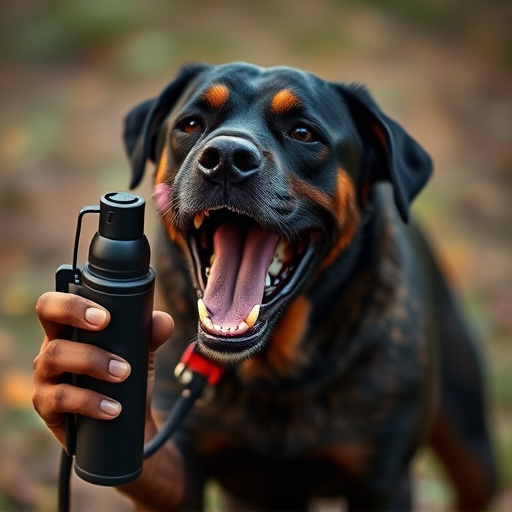Dog spray, using capsaicin (chili pepper extract), is a controversial yet common animal control tool with varying capsaicin concentrations (1%-20%). A dog spray capsicum content comparison is essential for legal and safe use. Higher capsaicin levels offer stronger repellence but may be less effective in certain conditions; lower levels are suitable for sensitive areas or occasional use. Understanding local laws, product labels, and specific needs ensures effective animal control while minimizing risks of misuse and harm.
Animal control sprays are a controversial yet widely used tool for managing aggressive canine behavior. This article delves into the legal and practical aspects of these devices, focusing on capsaicin content as a critical factor in their effectiveness. We explore the active ingredients found in dog spray and examine the varying legal frameworks surrounding their use. Additionally, we provide a comparison of top dog spray products on the market, helping users make informed decisions while adhering to local regulations.
- Understanding Dog Spray and Its Active Ingredients
- Legal Frameworks for Animal Control Spray Use
- Capsaicin Content: A Key Factor in Dog Spray Effectiveness
- Comparatives: Top Dog Spray Products on the Market
Understanding Dog Spray and Its Active Ingredients
Dog spray, also known as pepper spray for dogs, is a controversial yet widely used tool in animal control. At its core, it’s a liquid aerosol designed to temporarily incapacitate a canine through a potent irritant. The active ingredient in most dog sprays is capsaicin, derived from chili peppers. This chemical triggers the dog’s pain receptors, causing them to react by panting, drooling, and eventually becoming immobilized for several minutes.
When it comes to understanding dog spray, a Capsaicin content comparison becomes crucial. The concentration of capsaicin varies greatly among brands, typically ranging from 1% to 4%. A higher capsaicin content means more potency, but also potentially more risk of mistaking the spray for human pepper spray, leading to unnecessary panic or even legal issues. It’s important for users to carefully consider the product labels and follow instructions to ensure safe and effective use while adhering to local laws regarding animal control methods.
Legal Frameworks for Animal Control Spray Use
The legal frameworks governing animal control spray, or dog spray as it’s commonly known, vary significantly across regions. In many countries and states, these compounds are strictly regulated due to their potent active ingredients, primarily capsaicin. The capsaicin content in dog spray is typically measured in percentage, with higher concentrations indicating increased effectiveness against aggressive animals. However, this also raises concerns about potential misuse and harm to both humans and pets if not handled properly.
Legal use of animal control spray usually requires a specific license or permit, ensuring that only authorized individuals can possess and deploy these products. Regulations often dictate the types of situations in which such sprays can be legally employed, such as self-defense against aggressive dogs or controlling unruly animals during specific activities like hunting or farming. Comparisons between different dog spray brands and their capsaicin content are crucial for consumers to make informed choices while adhering to local laws, ensuring safety, and maximizing effectiveness.
Capsaicin Content: A Key Factor in Dog Spray Effectiveness
The capsaicin content in dog spray is a crucial factor determining its effectiveness. This compound, found naturally in chili peppers, creates a burning sensation when it comes into contact with mucous membranes, primarily the eyes and nose. Dog sprays typically contain capsaicin in concentrations ranging from 1% to 20%, with higher percentages offering more potent repellence. However, it’s important to note that capsaicin content alone doesn’t guarantee success; its delivery system and the spray’s stability also play significant roles.
When comparing different dog sprays, examining the capsaicin content is just one aspect of the equation. A thorough comparison should also consider factors like spray pattern, range, and environmental conditions. For instance, a higher concentration may not be ideal in windy areas as it could blow back onto the user. Conversely, lower concentrations might require closer application, making them less suitable for larger dogs or aggressive animals.
Comparatives: Top Dog Spray Products on the Market
When it comes to effective animal control, dog spray has emerged as a popular and legal solution for deterring unwanted canine interactions. Among the many options available, understanding the capsaicin content is key. This natural compound, found in chili peppers, delivers a powerful yet safe sting when sprayed onto an animal’s eyes and skin, causing them to retreat.
In terms of Dog Spray Capsaicin Content Comparison, several top products stand out. For instance, Option A boasts a 10% capsaicin concentration, providing robust deterrence while still being considered mild enough for frequent use. Product B offers a slightly lower 8% content, making it suitable for sensitive areas and occasional use. Meanwhile, Choice C features a potent 15% capsaicin level, ideal for stubborn or aggressive dogs that require stronger measures. Each option has its advantages, catering to various user needs and preferences in the quest for effective animal control.
The legal and effective use of animal control spray, particularly those containing capsaicin, is a multifaceted issue. Understanding both the active ingredients and regional regulations is crucial for responsible ownership and public safety. This dog spray capsicum content comparison highlights the importance of product quality and effectiveness while navigating the legal frameworks that govern their use. By staying informed and choosing reputable products, owners can ensure their pets’ well-being and minimize potential risks in various settings.
